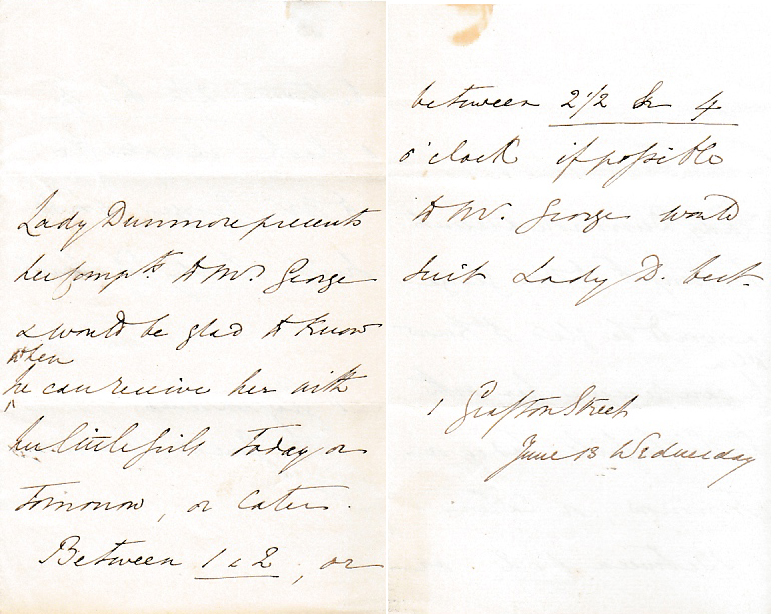The appointment letters of John Durancé George, Dental Surgeon
Writer: Lady Dunmore
Date: Wednesday 13th June 1849
Address: 1 Grafton Street
Lady Dunmore presents
her compts to Mr. George
& would be glad to know
when he can receive her
with her little girl today or
tomorrow, or later.
Between 1 & 2, or
between 2½ & 4
o’clock if possible
to Mr. George would
suit Lady D. best.
1 Grafton Street
June 13 Wednesday

Notes:
Born Lady Catherine Herbert at Arlington Street, St James's, Lady Dunmore was a daughter of George Herbert, 11th Earl of
Pembroke and his second wife, the former Countess Catherine Romanovich, daughter of the Russian Ambassador to the Court of
St. James's.
On 27th May 1836, Lady Catherine married Alexander Murray, Viscount Fincastle at Frankfurt am Main. Fincastle acceded
to his father's earldom of Dunmore a few months later. The couple had four children:
- Lady Susan Catherine Mary (1837-1915)
- Lady Constance Euphemia Woronzow (1838-1922)
- Charles Adolphus, styled Viscount Fincastle, later 7th Earl of Dunmore (1841-1907)
- Lady Victoria Alexandrina, or Lady Alexandrina Victoria Murray (1845-1911), married Rev. Henry Cunliffe (1826-1894)
In 1841 Lady Dunmore was appointed a Lady of the Bedchamber to Queen Victoria but resigned upon her husband's death
four years later. Following his death, she inherited 150,000 acres (610 km²) of the Dunmore estate on the 'isle' of Harris.
During the economic difficulties of the Highland Potato Famine of 1846-7, Lady Dunmore was instrumental in the promotion
and development of Harris Tweed, a sustainable and local industry. Recognising the sales potential of the fabric, she had the
Murray family tartan copied in tweed by the local weavers and suits were later made for the Dunmore estate gamekeepers and
gillies. Proving a success, Lady Dunmore sought to widen the market by removing the irregularities, caused by dyeing,
spinning and weaving (all done by hand), in the cloth to bring it in line with machine-made cloth. She achieved this by
organising and financing training in Alloa for the Harris weavers and by the late 1840s, a London market was established,
which led to an increase in sales of tweed.
The Countess died, aged seventy-one, on 12 February 1886 at Carberry Tower, Inveresk, East Lothian and was buried at
Dunmore, Stirlingshire.

